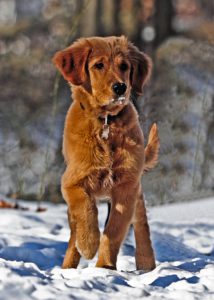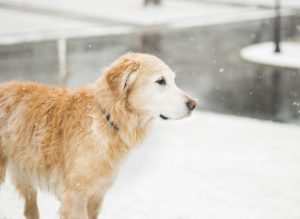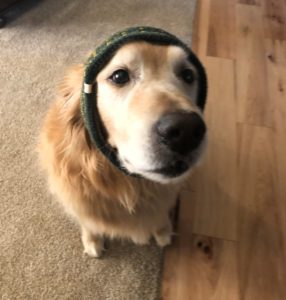Most dog owners are aware of the dangers that summer can pose for their dog, but there are also several dangers when it comes to the cold weather temperatures and to snow.

This scarf won’t keep your dog warm in the winter.
Dogs in the cold weather need to be watched to make sure they aren’t having any issues with the temperatures or their paws.
The cold weather tolerance will vary from dog to dog, just as it varies from person to person. It will be based on how thick their coat is, the activity level that your dog will be extending, the amount of body fat your dog has and their overall health.
You will need to learn what level of tolerance your dog has for the cold.
Table of Contents
Exercising Your Dog In Cold Weather
Just because the weather gets colder, doesn’t mean your dog isn’t going to be looking for their daily walk and outside activities. It does mean that you are going to need to make some adjustments to how long you are outside, and you are going to have to keep a closer eye on your dog to make sure they are handling the cold OK.
At 45 degrees, some dogs could become uncomfortable outside. At 32 degrees, small dogs, dogs with thin coats and very young or older dogs will start to be very uncomfortable at these temperatures. If the weather is 20 degrees or lower, dogs could start experiencing hypothermia and frostbite.
Medium and large healthy dogs can walk for 30 minutes if the temperature is about 20 degrees. Small dogs can walk 15-20 minutes at temperatures above 20 degrees. When the temperatures get colder, I recommend that you take your dog for shorter walks but more frequently.
Walk you dog in late morning or early afternoon if possible. Generally the temperatures will be a bit warmer in the middle of the day.
Frostbite
Frostbite begins when the dog’s body gets cold. Their body will pull blood from the extremities to the center of the body to help them stay warm.

Keep an eye on your dog in cold weather
Ears, paws and tail can get so cold that ice crystals can form and damage the skin. Frostbite isn’t easily detected right away. It might be a few days after the damage is done before you even notice that your dog has frostbite.
Watch for signs of pale or gray skin. It could also make the skin turn hard and cold.
As the skin warms, it can be extremely painful. It could eventually turn black. If you believe that your dog has gotten frostbite, contact your veterinarian to find out what they suggest for medical care.
Hypothermia
Hypothermia occurs when a dog spends too much time in the cold, gets wet in cold temperatures or when dogs with poor health or circulation are exposed to the cold. In mild cases, your dog will shiver and their ears and feet may grow cold.
As it progresses, they could show signs of depression, lethargy and weakness. Hypothermia will continue to worsen if you don’t get your dog inside and warm them up. The next step of hypothermia is the muscles will stiffen, heart and breathing rates will slow down and they will not respond to stimuli. Severe cases are life threatening.
Signs of hypothermia could be whining, shivering, or anxious. They might slow down or stop moving. They could seem weak or start looking for a warm place to burrow. If you see any of these signs, you need to immediately get your dog inside and warm them up.
Dogs Most Affected By Cold Weather
Small dog’s bellies are closer to the ground or snow and will get cold easier than larger dogs that are further off the ground. Also, dogs that have shorter fur will get cold quicker than dogs with thick long fur as they have less protection.
Body fat will also come into play for keeping your dog warmer. Body fat is a cold insulator and thinner dogs tend to get cold quicker than dogs with more body fat on their body. That doesn’t mean to over feed your dog though, as your dog could have more health issues from being overweight.
The color of your dog’s coat can keep your dog warmer or colder depending on the color. Black, brown and other dark colored dogs will absorb significant amounts of heat from the sun on sunny days.

Darker dogs will stay warmer from the sun.
Cold weather may worsen arthritis. If you have a dog with arthritis or an elderly dog, you will have to be more careful with them. They will be stiffer and not be as mobile walking on snow and ice. They have a better chance of slipping or falling during the winter.
Dogs with diabetes, heart disease and kidney disease will have a harder time regulating their body temperature. The same is for very young dogs and senior dogs. All of these dogs will need to greatly reduce the amount of time they spend outdoors when temperatures are below 32 degrees.
Care For Your Dog In Cold Weather
When you get back from walking your dog in the cold weather, check your dog’s paws over. Watch for signs of cold weather injury. You could see cracked paw pads or bleeding on the paws. You can apply coconut oil to dry or cracking areas of the paws.
Wipe down your dog’s paws after a walk. This will help protect them from chemicals they could have gotten on their feet. Salt on the roads or possible antifreeze is dangerous for your dog, and wiping down your dog’s paws will get them clean before they lick their feet.
Watch for limping during a walk. It could be ice accumulation between his toes. You can reduce ice ball accumulation by clipping the hair between your dog’s toes.
Avoid frozen ponds and lakes in the winter. It is hard to know how thick the ice is, and you don’t want your dog possibly falling through the ice.
Keep your dog well groomed. When your dog’s fur is groomed and not knotted up, it will help keep your dog properly insulated.
Dog Clothes For Cold Weather
Smaller dogs and dogs with short fur can really benefit from having either a sweater or coat in the cold winter months. Have several of them, so one is always dry. A wet coat or sweater can make them even more cold.
months. Have several of them, so one is always dry. A wet coat or sweater can make them even more cold.
A good coat or sweater should reach from the neck to the base of the tail. It should also protect their belly. You should still be cautious of the temperatures with you dog even if they are wearing a coat or sweater. Sweaters and coats won’t prevent frostbite on their ears, feet or tail.
The dog coat that I recommend is the Hurtta Winter Coat. It is waterproof and light but very warm.
Doggy boots work well with some dogs as well. This will help prevent the ice balls from forming in between their toes.
Make sure that they fit properly. Place your dog’s paw on a piece of paper and push down so the paw spreads the way it would spread when your dog is walking. Make a mark on the right and left side of the paw and then measure the distance between the lines. Compare this size with the different boot sizes.
Take a look at how to size dog boots properly. There is many helpful tips.
Outdoor Dogs
There are precautions that you need to take if you have an outdoor dog. No dog should be left outside for long periods of time in below freezing weather. They will need to be brought in to warm up.
Provide a shelter for your dog that will help keep them warm and offer them protection from the wind. The shelter should be off the ground to minimize heat loss into the ground. Provide them with bedding that is thick and dry.
An outdoor dog will require more calories in the winter to generate enough body heat and energy to help keep them warm. Provide plenty of non frozen water. A heated water bowl will help with this, or you will need to check their water frequently to make sure it isn’t frozen. Never use a metal water bowl in the winter, as your dog’s tongue could get stuck to the bowl.

Outdoor dogs need protection from the wind.
Summary
The best thing for dogs in the cold weather is to use common sense. If it is too cold for you, it is probably too cold for your dog. Your dog will still need daily activities when the weather is cold, but you will need to limit the amount of time that they spend outside.

This isn’t enough protection from the winter weather.
Plan on some indoor activities for your dog to keep them active and provide them with some type of mental stimulation to keep them active. Here is an article on mental stimulation if you need ideas of what would work great to help your dog stay active and happy on the days he can’t spend much time outside.
Please leave any questions or comments below and I will get back to you. If you found this article helpful, you can follow me on Pinterest, FaceBook and Twitter to receive new articles as they come out.

Hi Marla!
Such an informative post! I never knew a dog could get frostbite that quick! I have a small dog and I will be watching him much closer now. He is my child and I want him safe! I wish my dog liked sweaters but I stick them on him anyways hahah. Always great to see his pouty face look at me.
Thanks for the post Marla! Cannot wait to read more!
Thanks for reading Katie, and I’m glad you found useful information. I am sorry your dog doesn’t like sweaters, but it will help protect them. Usually small dogs don’t want to stay outside long enough to get frostbite, but it is possible. The pouty face does probably make you laugh though. Please come back again.